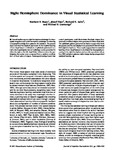Right hemisphere dominance in visual statistical learning
| dc.contributor.author | Roser, M | |
| dc.contributor.author | Fiser, J | |
| dc.contributor.author | Aslin, RN | |
| dc.contributor.author | Gazzaniga, M | |
| dc.date.accessioned | 2019-07-12T14:40:41Z | |
| dc.date.available | 2019-07-12T14:40:41Z | |
| dc.date.issued | 2011-05-01 | |
| dc.identifier.issn | 0898-929X | |
| dc.identifier.issn | 1530-8898 | |
| dc.identifier.uri | http://hdl.handle.net/10026.1/14638 | |
| dc.description.abstract |
<jats:title>Abstract</jats:title> <jats:p>Several studies report a right hemisphere advantage for visuospatial integration and a left hemisphere advantage for inferring conceptual knowledge from patterns of covariation. The present study examined hemispheric asymmetry in the implicit learning of new visual feature combinations. A split-brain patient and normal control participants viewed multishape scenes presented in either the right or the left visual fields. Unbeknownst to the participants, the scenes were composed from a random combination of fixed pairs of shapes. Subsequent testing found that control participants could discriminate fixed-pair shapes from randomly combined shapes when presented in either visual field. The split-brain patient performed at chance except when both the practice and the test displays were presented in the left visual field (right hemisphere). These results suggest that the statistical learning of new visual features is dominated by visuospatial processing in the right hemisphere and provide a prediction about how fMRI activation patterns might change during unsupervised statistical learning.</jats:p> | |
| dc.format.extent | 1088-1099 | |
| dc.format.medium | Print-Electronic | |
| dc.language | en | |
| dc.language.iso | en | |
| dc.publisher | MIT Press - Journals | |
| dc.subject | Attention | |
| dc.subject | Case-Control Studies | |
| dc.subject | Concept Formation | |
| dc.subject | Discrimination Learning | |
| dc.subject | Dominance, Cerebral | |
| dc.subject | Female | |
| dc.subject | Form Perception | |
| dc.subject | Humans | |
| dc.subject | Matched-Pair Analysis | |
| dc.subject | Middle Aged | |
| dc.subject | Pattern Recognition, Visual | |
| dc.subject | Probability Learning | |
| dc.subject | Reference Values | |
| dc.subject | Space Perception | |
| dc.subject | Split-Brain Procedure | |
| dc.subject | Young Adult | |
| dc.title | Right hemisphere dominance in visual statistical learning | |
| dc.type | journal-article | |
| dc.type | Article | |
| plymouth.author-url | https://www.ncbi.nlm.nih.gov/pubmed/20433243 | |
| plymouth.issue | 5 | |
| plymouth.volume | 23 | |
| plymouth.publication-status | Published | |
| plymouth.journal | Journal of Cognitive Neuroscience | |
| dc.identifier.doi | 10.1162/jocn.2010.21508 | |
| plymouth.organisational-group | /Plymouth | |
| plymouth.organisational-group | /Plymouth/Faculty of Health | |
| plymouth.organisational-group | /Plymouth/Faculty of Health/School of Psychology | |
| plymouth.organisational-group | /Plymouth/REF 2021 Researchers by UoA | |
| plymouth.organisational-group | /Plymouth/REF 2021 Researchers by UoA/UoA04 Psychology, Psychiatry and Neuroscience | |
| plymouth.organisational-group | /Plymouth/Research Groups | |
| plymouth.organisational-group | /Plymouth/Research Groups/Centre for Brain, Cognition and Behaviour (CBCB) | |
| plymouth.organisational-group | /Plymouth/Research Groups/Centre for Brain, Cognition and Behaviour (CBCB)/Brain | |
| plymouth.organisational-group | /Plymouth/Users by role | |
| plymouth.organisational-group | /Plymouth/Users by role/Academics | |
| dc.publisher.place | United States | |
| dc.identifier.eissn | 1530-8898 | |
| dc.rights.embargoperiod | Not known | |
| rioxxterms.versionofrecord | 10.1162/jocn.2010.21508 | |
| rioxxterms.licenseref.uri | http://www.rioxx.net/licenses/all-rights-reserved | |
| rioxxterms.type | Journal Article/Review |


